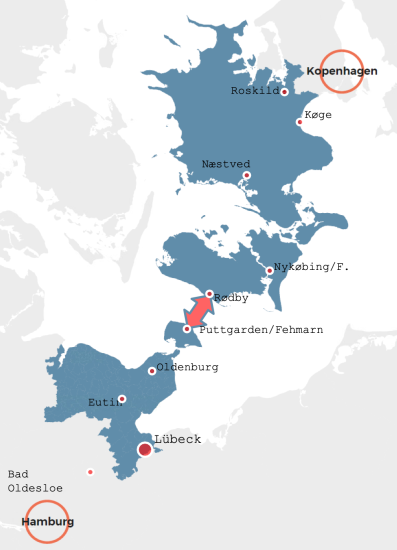
Danish-German cooperation across the Fehmarn Belt is moving into a more formal and dynamic phase.
The German development agency Wirtschaftsförderung Lübeck (WIFØ) and the Danish Femern Belt Development (FBD) want to strengthen cross-border cooperation through an Interreg project.
The project “Fehmarnbelt Growth Corridor” will prepare the creation of an actual Fehmarn Belt Region.
WIFØ and FBD, together with several German and Danish partners, have applied to Interreg for funding of the three-year project.
The budget is 1.7 million euros (about 12.8 million DKK).
From autumn 2026 the project will examine the possibilities for creating a joint Danish-German company, for example a European Grouping of Territorial Cooperation (EGTC).
The type of organization can provide a legal basis for future joint cross-border development projects.
Targeted, coordinated, and formalised cooperation
“We have already seen many Danish-German development projects carried out by business organisations, educational institutions and municipalities.
The goal has been to support growth in a shared cross-border region.
Interest in cooperation is rising on both sides of the Fehmarn Belt.
We have therefore reached a point, ahead of the opening of the fixed Fehmarn Belt connection, where we need a more targeted, coordinated and formalised cooperation in a common organisation. Such an organisation must have the European legal basis to start initiatives that can strengthen regional development, business life, innovation and mobility in the future Fehmarn Belt Region,” says CEO Stig Rømer Winther, Femern Belt Development.
Partners and network partners
Fehmarnbelt Growth Corridor will be run by Wirtschaftsförderung Lübeck and Femern Belt Development in partnership with the Chamber of Industry and Commerce in Lübeck, the Hanseatic City of Lübeck and Kreis Ostholstein on the German side, and Lolland Municipality and Næstved Municipality on the Danish side.
In addition, a number of network partners are connected to the project.
On the Danish side these are:
Region Zealand, Guldborgsund Municipality, Business Vordingborg, Business Lolland-Falster, Faxe Municipality, Køge Municipality, Roskilde Municipality, Langeland Municipality, Ringsted Municipality and STRING.
Model region for European integration
During the three years, the Fehmarnbelt Groth Corridor project will carry out several analyses.
The goal is to prepare the possible project organization for the opening of the fixed Fehmarn Belt connection.
Analyses will cover i.e. economy, business development and knowledge transfer, education and labour, tourism and culture, as well as health and social conditions.
The project will also define the goals for the future Danish-German cooperation, create the foundation for the legal organisation and prepare the approval process.
“We want to establish a joint Danish-German development organization.
It will coordinate the building of the new Fehmarn Belt Region and ensure that both sides benefit as much as possible from the Fehmarn link,” says Stig Rømer Winther.
Facts about EGTC
EGTC stands for European Grouping of Territorial Cooperation.
It is a legal entity created by the EU that allows public authorities from different countries to cooperate across borders in a simple and lawful way.
Examples of existing EGTCs:
Euregio EGTC (Germany–Netherlands), working with regional development in business, culture and mobility.
Lille Européenne Métropole EGTC (France–Belgium), working with planning, urban development and infrastructure.
EGTC GO (Italy–Slovenia), managing joint health projects and cultural initiatives.

